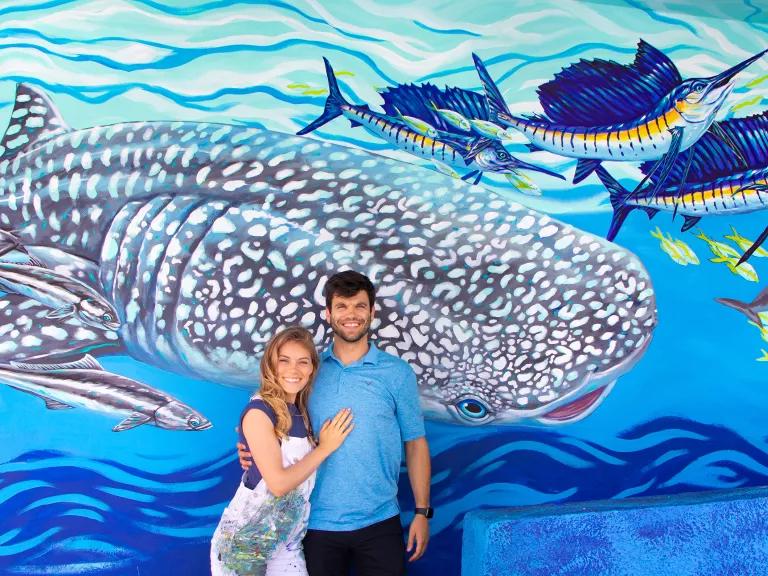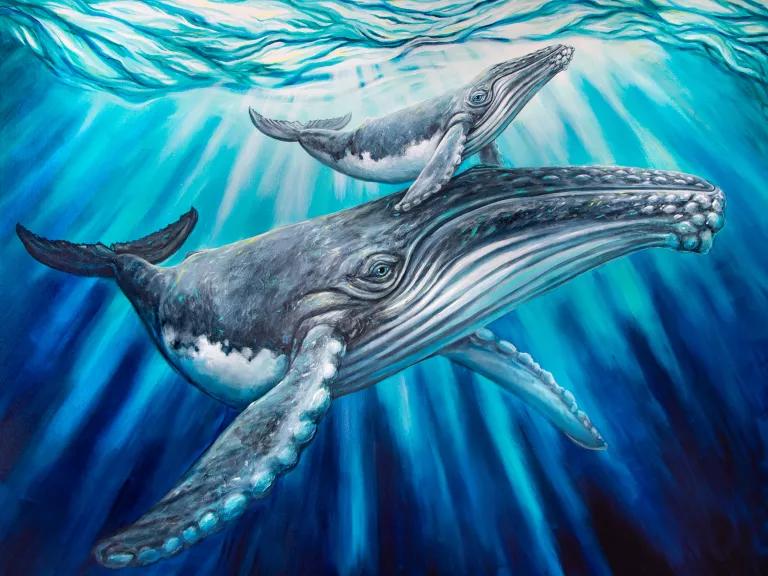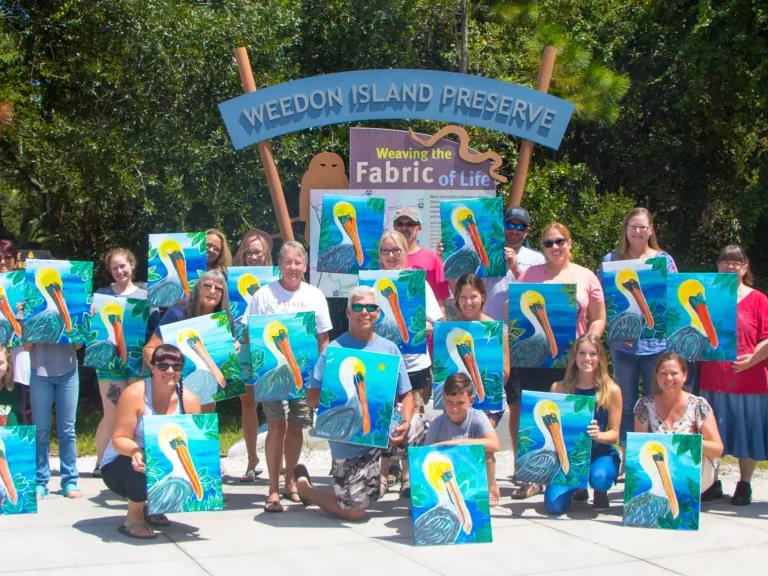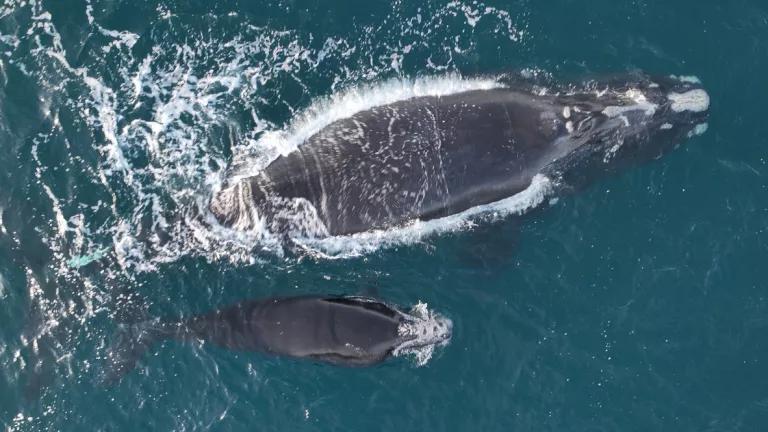
Kelly Quinn with original acrylic on canvas
Kelly Quinn
This is the second installment of the Rice’s Whale Artist Series, highlighting local artists that create inspiring works of art to raise awareness about the magnificent and critically endangered Gulf of Mexico (also known as Rice’s) whales.
Based in St. Petersburg, Florida, Kelly Quinn is the Co-founder and Art Director of Canvas of the Wild (COTW) where she designs natural landscape murals for educational campaigns, creates illustrations for coloring and activity books, and develops scientific graphics for communicating research. Quinn is an exceptional and accomplished artist that works with local communities, museums, science organizations, and researchers. With NRDC’s Lexi Nutkiewicz, Quinn discusses her inspiration for starting COTW, her creative process, and her thoughts on the current state of ocean conservation. This interview has been edited for length.

Canvas of the Wild Team (Image with Blake & Kelly with Mural)
Kelly Quinn
Lexi Nutkiewicz: What led you to start Canvas of the Wild?
Kelly Quinn: Blake and I have known each other for a very long time and we love working together. He’s got this wonderful mind for seeing the big picture and finding those special ideas. I’m focused on my art and the tiny details, so we make a good team. We decided to co-found Canvas in the Wild in 2018. Originally, we were doing a mix of things that were much more localized, for example, we did a lot of art classes. I would go out and teach classes at parks and [nature] preserves.
We were out one day and Blake noticed that the signage was out of date and how it’d be nice if we could help update signage so people could be educated about this awesome place we love. So that’s actually how Canvas of the Wild got started and then it just snowballed. We did more interactive experiences with people in Tampa Bay and throughout the whole Gulf coast of Florida.
But then COVID happened and we ended up developing our next big thing - our coloring book. Our first coloring book was Color Your Way Through Wild Florida. That was created as a way to make sure that people had hands-on art experiences at home and share with their friends and family. Although, a core driver for both of us was the educational element. With the Wild Florida book, we introduce 7 key habitats, following the flow of the water, so we go from the upland scrub areas, all the way down to the mangroves where wild Florida ends. Within each of these habitats, we highlight species that are either unique to Florida or iconic. On each of these pages we have a fun fact, a few sentences about the animal, and information about each habitat.
Since then we’ve published an ocean coloring book Color Your Way Through Florida’s Coastal Waters and now do other services, such as activity books and online e-guides. We’re also working on children’s books and working with different organizations to communicate a specific mission-driven outcome. For example, we recently worked with the Florida Wildlife Federation on a native gardening guide. We love doing these really interesting concepts involving the community in different ways. And it’s only growing.

Sea of Hope - acrylic on canvas
Kelly Quinn
What are your thoughts on the current state of ocean conservation?
KQ: I have mixed thoughts. It’s tough because on the bright side, there are more people aware and caring than there ever has been, and more people have the ability to speak about it. I think if you can help people understand that reality in a kind and honest way, you can do so much with that. While policy is ultimately the thing that helps push the change long-term, speaking about it matters. There’s so much work into getting somebody interested, to begin with, to even care about the policy. That’s where I find that we fit in - the educational sphere of creating things that inspire people to be curious and see the relevancy to why we need to protect their wildlife and our oceans, and how we have an impact on our oceans. I’d say nowadays we are doing more work that’s very focused on that edge between science and outreach. We serve scientists who want to have materials for their reports to be able to eventually inform policy. But we also want to be able to communicate to wider audiences.
We’re always trying to be approachable and not trying to get people angry or upset - that’s not productive. We focus heavily on the animals themselves because that in of itself is important. You need to be able to connect with the animal that is dealing with whatever conditions are happening and how to see yourself speaking for those animals. There’s a difference between the scientific aspects that I work on, and then the personal artwork that I work on for galleries or collectors. There’s much more of a story associated with those personal pieces, that relation to humans and capturing personality and sharing the likeness. Any time I see an animal, I don’t see them as an “other,” they’re just another neighbor.
Back to the topic of conservation, I do have hope for a future where humans recognize the importance of balance and respect the natural world, but the growing pains to get to that point are not going to be easy. I’d say that everything that is happening today when it comes to climate change, coral bleaching, species extinction, and ice melting is the importance of making these events known to the general public. We need to continue to communicate why it’s important to wildlife and humans, and share how people can get involved with policy.

Weedon Island art class
Kelly Quinn
You’ve had a very big social impact on these communities already, so what social impact would you like to strive for next?
KQ: What we’re doing right now is exactly what I want to be doing. I love it. I’d probably say creating more data visualizations for scientists, research organizations, and organizations like the NRDC; where visuals can be utilized in reports to inform policy decisions, and creating graphics to help communicate science for outreach, policymakers, or social media. There’s a wide breadth of opportunities where the arts can inform the sciences and help bridge that gap between people’s understanding of the concept and people just not even knowing about the concept. I enjoy using what I have access to do and hope to make that grow and eventually move into animation. Animation is something I’m still learning. I’ve done some 30-40 second informational ones about coral. I haven’t done any that are story-driven yet, but soon.

Florida Wildlife Corridor Foundation Mural unveiling at Crystal River
Kelly Quinn
Any final call to action?
KQ: Change doesn’t just happen with one person. I have the support of Blake and so many others over the years who helped me get to where I am today. Keep finding your people, your community and keep building that community and sharing what you’re passionate about. And if you have a creative spirit, in any way, whether it be writing, speaking, dancing, artwork, music. It’s all important and useful to communicate change because it speaks to the human spirit.
To read the full interview with Kelly, click here.
You can follow Kelly at @kellyofthewild and Canvas of the Wild at @canvasofthewild




